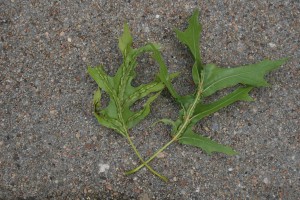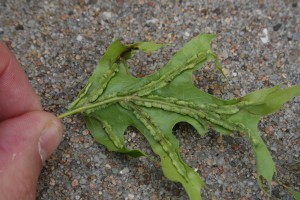–by Dr. Raymond Cloyd
We continue to receive inquiries regarding gall-like growth on the underside of pin oak (Quercus palustris) leaves. In some cases, many pin oak trees have extensive galling on nearly all the leaves. In fact, two trees on the Kansas State University (Manhattan, KS) campus located behind Umberger Hall should be considered the poster-children for this gall as they are so heavily infested. The culprit is the vein pocket gall, which is caused by the gall-midge, Macrodiplosis quercusoroca. Galls are elongated, pocket-like swellings on the lateral veins
and mid-rib of pin oak leaves (Figures 1 and 2). The gall-making organism is a small-fly called a midge (Family: Cecidomyiidae). Adults are 3.0 mm long and resemble small mosquitoes. Female midges attack newly unfolding leaves just before they flatten out. Following egg hatch, the small larvae or maggots migrate to the lateral and mid-veins and begin feeding. After a few days, tissue forms and surrounds each larva. The fully-grown larva is white and approximately 2.0 mm in length. Development is completed by mid-spring to early summer. Larva eventually emerges from the gall, fall to the ground, and overwinter or enter diapause (a physiological state of arrested development) until next spring. There is one generation per year. There is no control for this gall. Just live with it and enjoy the pleasures of one of nature’s most fascinating insect-plant interactions.

